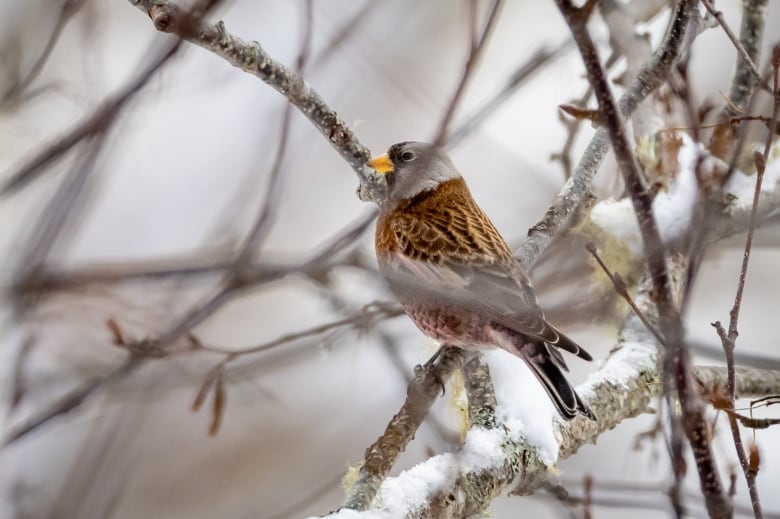Birders in a flap after rare gray-crowned rosy finch spotted in Nova Scotia
The finch typically nests in the mountainous regions of western North America

Birders from across the region have been flocking to Green Bay in Lunenburg County after a resident photographed a rare bird on her property earlier this month.
Lynette Barnes said she makes a habit of waking up early to take a photo of the sunrise and spotted the gray-crowned rosy finch on Jan. 11.
The gray-crowned rosy finch is normally only seen in western North America, from New Mexico to Alaska, according to the Audubon Guide to North American Birds.
Barrnes told CBC Radio's Maritime Noon she first thought it was a starling and posted a picture of it on her Facebook page.

On Saturday, Barnes said, she took another photo and uploaded it to Merlin Bird, a bird identification site, which named it as the finch.
Barrnes then posted the photo to the Nova Scotia Bird Society Facebook page, where it caused quite a stir.
'Mega' sighting for birders
One of the people excited to see the photo was wildlife photographer Jason Dain, who contacted Barnes eight minutes after the photo was posted.
After asking for permission to visit her and see the bird in person, Dain drove 100 kilometres from his home in Upper Tantallon, N.S., to catch a glimpse and take photographs.
Dain said seeing a gray-crowned rosy finch in this part of the world is so rare, it is categorized as a "mega" sighting because the bird has "no business being here."
"They are the highest breeding bird in North America, so they have been recorded breeding at the top of Denali Mountain [in Alaska]," Dain said.
"I saw my first one in Montana on Logan Pass — which is about 2,500 metres or 7,000 feet above sea level, you know — on a snowbank in July. You really have to go to high altitudes to see these birds."
Dain said this is likely the only chance Atlantic Canadians will have to see the bird, which could disappear tomorrow.

Blown by storms
Both Barnes and Dain speculate that the bird may have been blown to Nova Scotia by a series of recent winter storms.
Barnes said people have been coming from across the region to see the bird, including one birder who drove seven hours from Moncton, N.B.
She said she's not bothered and is happy to welcome people eager to see her rare visitor.
"I joke that we own a wildlife preserve here with all the animals and the birds that show up and my newest version ... is all these birders," Barnes said, adding that about 160 people have come.
"It's been incredible. I've met some great photographers, incredible, well-renowned birders who know more about all of this than I do. It's been fun, I have to say, and we're very happy to have anybody come to see this bird anytime they want."
With files from CBC Radio's Maritime Noon
